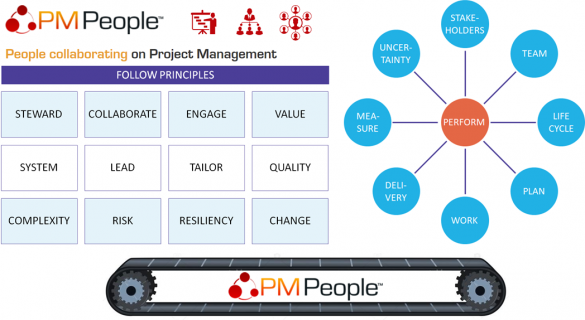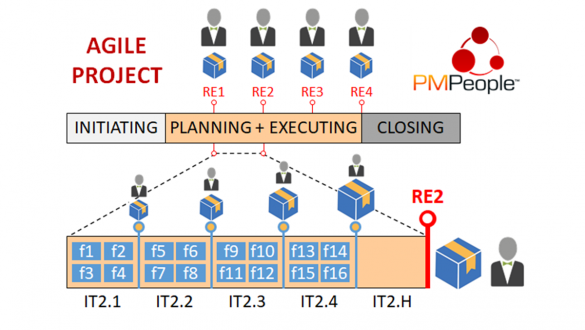Project Manager is a Profession
Project Management is a profession with a great future, but it must adapt to our times. Stakeholders expect the project to meet the business goals and deliver value. They don’t want us adding bureaucracy, wasting our time on paperwork, or even worse, wasting their time or team members time in meetings we should avoid. They need to know how the project is doing real time, just by getting evidence on 8 performance domains. Above all, they want the project to be predictable and to avoid crisis.
Controlling the Project Cost, in practice
To get the project finished under budget, we need to measure cost performance on each review date. Earned Value Management (EVM), is the ANSI 748 standard method to measure the project cost performance objectively. According to EVM standard, as of each status date, three measures are enough to analyze the project cost performance. Professional project managers can practice EVM effectively with PMPeople.
Practicing the PMBOK® Guide 7th Edition with PMPeople
PMPeople can be seen as a technology framework for practitioners who want to follow the new edition of the PMBOK: As a project manager, I can follow the 12 principles just updating the project data in PMPeople. As a stakeholder, I can check the project management outcomes on the 8 performance domains just getting the evidence of good or bad performance directly on PMPeople.
PMPeople to Control Agile Projects
1) Centralize professional project management in PMPeople: stakeholders engagement, risks, status reports, time sheets and expenses, etc. 2) decompose the project into work packages, meaning agile releases; 3) Connect work package #0 (the project itself) to Asana list for epics; 4) Connect each release to Asana list for user stories; 5) Managers do not need Asana: they use PMPeople to track epics and stories; 6) Team Members do not need PMPeople: they use Asana to follow their ceremonies and manage their artifacts.
Work Packages in the center of Professional Project Management
Work packages are the work defined at the lowest level of the work breakdown structure for which cost and duration are estimated and managed. Work packages are in the center of professional project management.
PMPeople to support NextGenerationEU
Spain has been granted 140,000 million euros from the Recovery Plan for Europe Next Generation EU. Does this imply we need to start managing 100,000 projects this year? Considering our bad track record on effective European funding execution, how to manage properly a budget four times bigger? The approach should integrate project governance, project professionals and project management technology.
AI applied to Project Management
Year 2030. PPM tools include AI features. People can talk to a chatbot to initiate new projects, prioritize them, or approve the project set adding the most aggregated value. AI can help on technical tasks related to planning, controlling, knowledge management, etc. AI helps mentoring project managers throughout their professional careers. AI is effective classifying and clustering thousands of projects belonging to business units, programs, and portfolios. AI saves a lot of time generating reports, assuring quality standards, etc. AI can answer questions like: What are the odds this project will finish on time? What is the value of this deliverable? What projects should be re-baselined? What teams should be restructured? What contracts should be canceled?
What is Artificial Intelligence?
As in every area of the economy, digital transformation has disrupted project management. In order to manage projects professionally, we do not need paper documents anymore. We do not need to work from specific locations, neither. Project data, essential for business management in the Project Economy, is growing exponentially. More and more people collaborate on projects, sharing more and more technical and management data, and organizations are executing more and more projects. With so much project management data available, could algorithms manage projects automatically? What will be our role as project management professionals?
Controlling Agile Projects
In agile projects, there is a disturbing complacency about failure. We are used to statements like «I’ve seen no software project delivered on time, on budget». Do you really think this a problem without a solution? If we let the team do their tasks but nobody is accountable for the project, why is it a surprise when the project is behind schedule and over budget? Agile projects must be controlled as well.
Agile Case Study (5/5): Closing the First Release
This is the fifth and last post on the chapter 23 of the book Agile Estimating and Planning, by Mike Cohn. In the previous post the team was about to start the first 2 week iteration, planned with 4 stories and 18 points. They also forecasted a…
Agile Case Study (4/5): Release Planning
Fourth post on the chapter 23 of the book Agile Estimating and Planning, by Mike Cohn. In the previous post the Havannah team met with on this agenda: First sprint planning. Market research outcomes review. Initial estimate for the release plan and the project schedule. First point…
Agile Case Study (3/5): Planning the First Sprint
Third post on the chapter 23 of the book Agile Estimating and Planning, by Mike Cohn. In the previous post the Havannah team had written 32 user stories, totaling 146 story points. In this post, team members are working on another project, while analyst Delanie start a…












